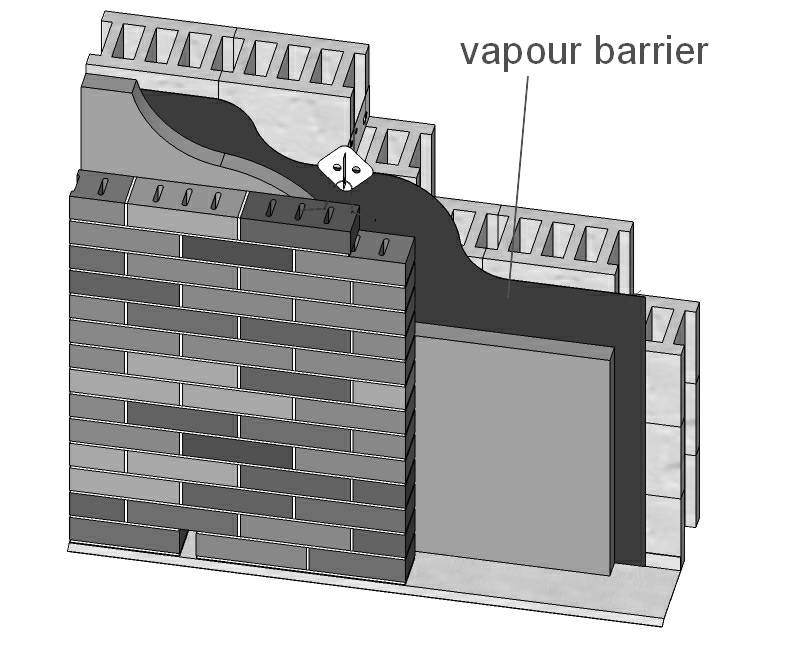Vapour barrier
As warm, moist internal air permeates through the external envelope of a building towards the outside, it will tend to cool. When it reaches its ‘dew point’ temperature, the moisture it holds will begin to condense as water. If this happens within the structure of the building itself, this is known as interstitial condensation.
If interstitial condensation occurs within the inner skin of the building envelope, it can cause problems such as:
- Mould growth, migration of salts, mildew and staining.
- Corrosion and decay of the building fabric.
- Frost damage.
- Poor performance of insulation.
To prevent this, vapour control layers (VCL) or vapour barriers are positioned on the warm side of the structure, preventing the warm moist air from penetrating to a point where it might reach its dew point temperature. In a traditional cavity wall construction for example, a vapour barrier might be introduced between the cavity insulation and the inner masonry skin.
Vapour barriers might also be used in timber frame constructions, roof and floor constructions as well as in high humidity buildings such as swimming pools and factories.
Care must be taken to ensure that vapour barriers are installed properly, so that they are continuous, and that joints, edges, junctions, cuts and penetrations are sealed. Particular care must be taken around openings such as ceiling hatches, and service penetrations such as cables, ducts, sockets, light fittings, and so on.
As well as preventing interstitial condensation, vapour barriers can improve the airtightness of the buildings. However, typically vapour barriers have a very low permeability, but are not completely airtight. Where they are airtight, they may be described as air and vapour control layers (AVCLs). Preventing the passage of air through the structure, can improve its thermal performance. In addition, some vapour barriers may include a low-e (low emissivity) metalised foil in their construction to improve thermal efficiency.
Vapour barriers may include an adhesive face, or adhesive laps and may have some ‘elastomric’ properties, giving a limited self-sealing capability if penetrated.
Some types of rigid foam insulation have a foil bonded to their surface which will act as a vapour barrier, however, care must still be taken to ensure that joints and edges are properly sealed.
NB Approved document C: Site preparation and resistance to contaminants and moisture, 2004 edition incorporating 2010 and 2013 amendments defines a vapour control layer as: ‘Material of construction, usually a membrane, that substantially reduces the water vapour transfer through any building in which it is incorporated.’
[edit] Related articles on Designing Buildings
Featured articles and news
The Building Safety Forum at the Installershow 2025
With speakers confirmed for 24 June as part of Building Safety Week.
The UK’s largest air pollution campaign.
Future Homes Standard, now includes solar, but what else?
Will the new standard, due to in the Autumn, go far enough in terms of performance ?
BSRIA Briefing: Cleaner Air, Better tomorrow
A look back at issues relating to inside and outside air quality, discussed during the BSRIA briefing in 2023.
Restoring Abbotsford's hothouse
Bringing the writer Walter Scott's garden to life.
Reflections on the spending review with CIAT.
Retired firefighter cycles world to raise Grenfell funds
Leaving on 14 June 2025 Stephen will raise money for youth and schools through the Grenfell Foundation.
Key points for construction at a glance with industry reactions.
Functionality, visibility and sustainability
The simpler approach to specification.
Architects, architecture, buildings, and inspiration in film
The close ties between makers and the movies, with our long list of suggested viewing.
SELECT three-point plan for action issued to MSPs
Call for Scottish regulation, green skills and recognition of electrotechnical industry as part of a manifesto for Scottish Parliamentary elections.
UCEM becomes the University of the Built Environment
Major milestone in its 106-year history, follows recent merger with London School of Architecture (LSE).
Professional practical experience for Architects in training
The long process to transform the nature of education and professional practical experience in the Architecture profession following recent reports.
A people-first approach to retrofit
Moving away from the destructive paradigm of fabric-first.
International Electrician Day, 10 June 2025
Celebrating the role of electrical engineers from André-Marie Amperè, today and for the future.
New guide for clients launched at Houses of Parliament
'There has never been a more important time for clients to step up and ...ask the right questions'
The impact of recycled slate tiles
Innovation across the decades.
EPC changes for existing buildings
Changes and their context as the new RdSAP methodology comes into use from 15 June.

























